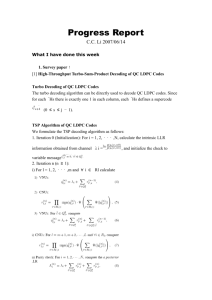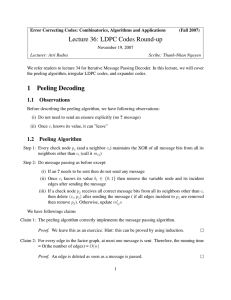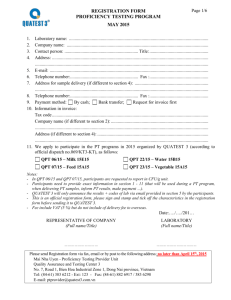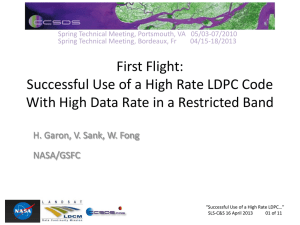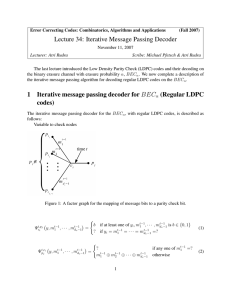Advance Journal of Food Science and Technology 10(5): 331-335, 2016
advertisement
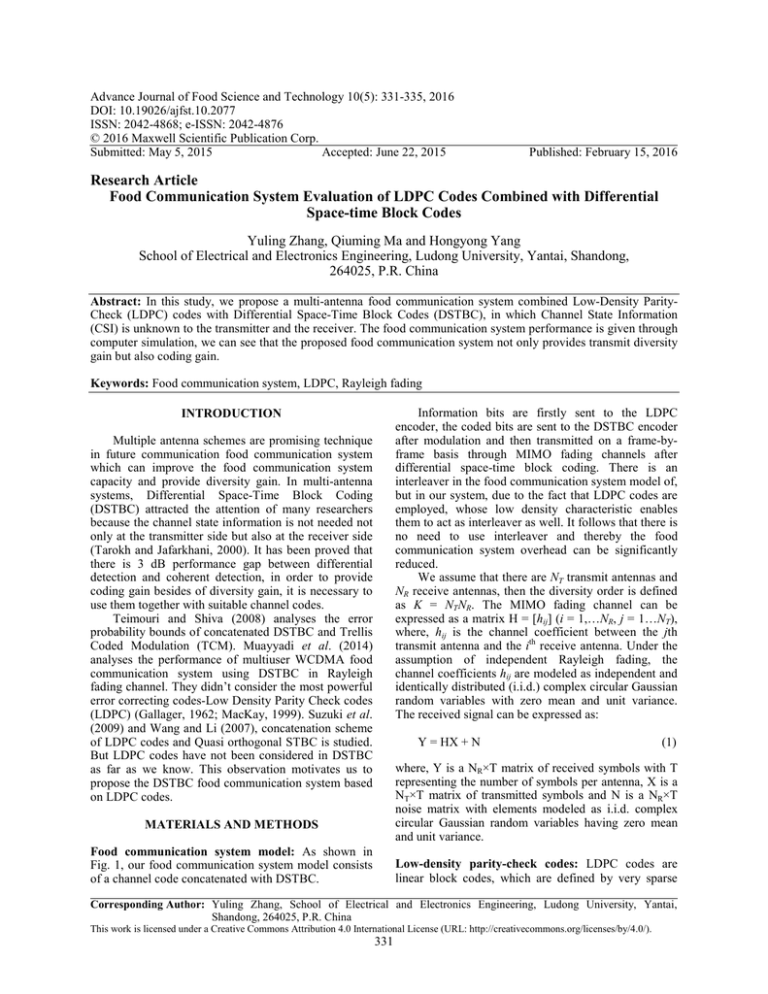
Advance Journal of Food Science and Technology 10(5): 331-335, 2016
DOI: 10.19026/ajfst.10.2077
ISSN: 2042-4868; e-ISSN: 2042-4876
© 2016 Maxwell Scientific Publication Corp.
Submitted: May 5, 2015
Accepted: June 22, 2015
Published: February 15, 2016
Research Article
Food Communication System Evaluation of LDPC Codes Combined with Differential
Space-time Block Codes
Yuling Zhang, Qiuming Ma and Hongyong Yang
School of Electrical and Electronics Engineering, Ludong University, Yantai, Shandong,
264025, P.R. China
Abstract: In this study, we propose a multi-antenna food communication system combined Low-Density ParityCheck (LDPC) codes with Differential Space-Time Block Codes (DSTBC), in which Channel State Information
(CSI) is unknown to the transmitter and the receiver. The food communication system performance is given through
computer simulation, we can see that the proposed food communication system not only provides transmit diversity
gain but also coding gain.
Keywords: Food communication system, LDPC, Rayleigh fading
Information bits are firstly sent to the LDPC
encoder, the coded bits are sent to the DSTBC encoder
after modulation and then transmitted on a frame-byframe basis through MIMO fading channels after
differential space-time block coding. There is an
interleaver in the food communication system model of,
but in our system, due to the fact that LDPC codes are
employed, whose low density characteristic enables
them to act as interleaver as well. It follows that there is
no need to use interleaver and thereby the food
communication system overhead can be significantly
reduced.
We assume that there are NT transmit antennas and
NR receive antennas, then the diversity order is defined
as K = NTNR. The MIMO fading channel can be
expressed as a matrix H = [hij] (i = 1,…NR, j = 1…NT),
where, hij is the channel coefficient between the jth
transmit antenna and the ith receive antenna. Under the
assumption of independent Rayleigh fading, the
channel coefficients hij are modeled as independent and
identically distributed (i.i.d.) complex circular Gaussian
random variables with zero mean and unit variance.
The received signal can be expressed as:
INTRODUCTION
Multiple antenna schemes are promising technique
in future communication food communication system
which can improve the food communication system
capacity and provide diversity gain. In multi-antenna
systems, Differential Space-Time Block Coding
(DSTBC) attracted the attention of many researchers
because the channel state information is not needed not
only at the transmitter side but also at the receiver side
(Tarokh and Jafarkhani, 2000). It has been proved that
there is 3 dB performance gap between differential
detection and coherent detection, in order to provide
coding gain besides of diversity gain, it is necessary to
use them together with suitable channel codes.
Teimouri and Shiva (2008) analyses the error
probability bounds of concatenated DSTBC and Trellis
Coded Modulation (TCM). Muayyadi et al. (2014)
analyses the performance of multiuser WCDMA food
communication system using DSTBC in Rayleigh
fading channel. They didn’t consider the most powerful
error correcting codes-Low Density Parity Check codes
(LDPC) (Gallager, 1962; MacKay, 1999). Suzuki et al.
(2009) and Wang and Li (2007), concatenation scheme
of LDPC codes and Quasi orthogonal STBC is studied.
But LDPC codes have not been considered in DSTBC
as far as we know. This observation motivates us to
propose the DSTBC food communication system based
on LDPC codes.
Y = HX + N
(1)
where, Y is a NR×T matrix of received symbols with T
representing the number of symbols per antenna, X is a
NT×T matrix of transmitted symbols and N is a NR×T
noise matrix with elements modeled as i.i.d. complex
circular Gaussian random variables having zero mean
and unit variance.
MATERIALS AND METHODS
Food communication system model: As shown in
Fig. 1, our food communication system model consists
of a channel code concatenated with DSTBC.
Low-density parity-check codes: LDPC codes are
linear block codes, which are defined by very sparse
Corresponding Author: Yuling Zhang, School of Electrical and Electronics Engineering, Ludong University, Yantai,
Shandong, 264025, P.R. China
This work is licensed under a Creative Commons Attribution 4.0 International License (URL: http://creativecommons.org/licenses/by/4.0/).
331
Adv. J. Food Sci. Technol., 10(5): 331-335, 2016
Fig. 1: Food communication system model
parity-check matrices H having dimension m*n. LDPC
codes are usually represented by bipartite graphs, in
which one set of nodes called the variable nodes,
corresponds to the information bits of the codeword and
the other set of nodes called the check nodes,
corresponds to the set of parity-check constraints which
define the codes. An LDPC code is called regular if
every variable node participates in dv check nodes and
every check node involves dc variable nodes, otherwise
it is called irregular. For an irregular LDPC code, the
degrees of each set of nodes are chosen according to
some distribution as following description. Given a
degree distribution pair (λ, ρ):
λ ( x ) = ∑ i = 2 λi x i −1 ρ ( x) = ∑ i = 2 ρi x i −1
dv
dc
where, the constants Kij are chosen to ensure qij (0) + qij
(1) = 1.
The forth step: Compute:
Qi (0) = K i (1 − Pi )∏ r ji (0)
j∈Ci
Qi (1) = K i Pi ∏ r ji (1)
j∈Ci
where, the constants Ki are chosen to ensure Qi (0) + Qi
(1) = 0.
The fifth step: make decision according to Qi:
1 Qi (1) > 0.5
cˆi =
else
0
(2)
where, λi (ρi) is nonnegative and λ (1) (ρ (1)) equals one,
λi (ρi) specifies the variable (check) node degree
distribution when the pair is associated to a sequence of
code ensembles Cn (λ, ρ). More precisely, λi (ρi)
represents the fraction of edges emanating from
variable (check) nodes of degree i. The maximum
variable degree and check degree are denoted by dv and
dc respectively. When it comes to degree i in a paritycheck matrix, it means the same as column weight i,
which is defined as the number of nonzero elements in
that column of the parity-check matrix. The decoding
scheme is performed as follows.
The first step: Initialize:
q ij ( 0 ) = 1 − Pi = Pr( x i = + 1 | y i ) =
q ij (1) = Pi = Pr( x i = − 1 | y i ) =
1 + e 2y i / σ
DIFFERENTIAL SPACE-TIME BLOCK CODES
In this section, we will briefly introduce the
encoder and decoder of DSTBC.
Encoding scheme: We consider a food communication
system with two transmit antennas and MPSK
modulation set A = {e2π kj / M / 2, k = 0,...M − 1} , where
M = 2b. After LDPC encoding and DSTBC encoding, s1
and s2 are transmitted at time 1, -s2* and s1* are
transmitted at time 2 from two antennas, which do not
carry any information. Suppose s2t-1 and s2t are sent
respectively from transmit antennas one and two at time
2t-1 and that -s*2t, s*2t-1 are sent, respectively from
antennas one and two at time 2t, we use the following
matrix to denote the orthogonal basis which act as the
reference to calculate the next transmitted symbols:
2
2
(3)
The second step: Operation on check nodes:
rji (0) =
1 1
+ ∏ (1 − 2qi ' j (1))
2 2 i ' ∈R j \ i
rji (1) = 1 − rji (0)
(4)
s
D ( st −1 ) = 2 t −*1
− s2 t
The third step: Operation on variable nodes:
qij (0) = Kij (1 − Pi )
∏r
j ' ∈C i \ j
qij (1) = K ijPi
∏r
j ' ∈C i \ j
j 'i
j 'i
(7)
If = 0 or the max-iterations is reached, the
decoding process is ended, otherwise go to the step one.
1
1 + e - 2y i / σ
1
(6)
(0)
s2 t
s2*t −1
(8)
Then s2t+1 and s2t+2 can be calculated as:
(1)
( s2t +1
(5)
332
s2t + 2 ) = M 21t+1 ( s2t −1
s2t ) + M 22t+1 (− s*2 t
s*2t −1 )
(9)
Adv. J. Food Sci. Technol., 10(5): 331-335, 2016
where, M2t-1 = (M12t-1 M22t-1) is the differential
coefficient vector. The differential encoding process as
(8) is inductively repeated until the end of the frame.
We demonstrate the above differential encoding
scheme by an example. Assume that the constellation is
BPSK consisting of the points 1/2 and -1/2, then the
mapping M maps two bits onto BPSK constellation is
given by (Tarokh and Jafarkhani, 2000):
N1 = (s2t+1 s2t +2 )HN2*t −1 + N2t +1H* (s2t −1 s2t )* + N2t +1N2*t −1
N2 = (s2t +1 s2t +2 ) HN2*t + N2t +1H * (−s*2t
The receiver computes the closest vector to (R1 R2),
which is M 2t −1 = (M 1 M 2 ) and the transmitted bits can
2 t −1
RESULTS AND DISCUSSION
The frame design of the early warning system of
food safety: In this section, we present simulation
results for both the performance of the DSTBC and
LDPC-DSTBC, BPSK, QPSK and 8PSK constellations
are considered. The fading is assumed to be constant
over frame and vary from one frame to another. As
shown in Fig. 2.
We construct the mother code by using the
Progressive Edge Growth (PEG) method, which has
been proven to be able to produce the best LDPC codes
with moderate code length and can generate a WeightIncreasing Parity-Check (WIPC) matrix. We employ
LDPC codes with rate 1/2 (504, 252) in our simulation,
the maximum iterations is eight. The variable node
degree distribution of irregular LDPC codes is as
follows:
Decoding scheme: For notational simplicity, we will
first present the results for one receive antenna. For
example, there are four signals r2t-1, r2t, r2t+1, r2t+2 are
received:
(r2t −1 r2*t ) = (s2t −1 s2t ) H + N2t −1
(10)
where, H is channel coefficients matrix redefined by:
h
H = 1
h2
h 2*
− h1*
2 t −1
be recovered by the inverse mapping of M2t-1.
M (00) = (1 0)
M (10) = (0 1)
M (01) = (0 -1)
M (11) = (-1 0)
(r2t +1 r2*t+2 ) = (s2t −1 s2t )H + N2t +1
s*2t−1 )* + N2t +1 N2*t
(11)
λ ( x) = ∑λi xi
i
= 0.47532x2 + 0.27953x3 + 0.03486x4 + 0.10889x5 + 0.10138x15
And N2t −1 = (n2t −1 n2t ) represent the AWGN noise.
After differential detection, we get a vector of (R1, R2):
R1 = ( h1
R 2 = ( h1
2
It has been proved that the performance of the
DSTBC is 3 dB worse than the STBC scheme which
employs coherent detection). Our scheme can
significantly compensate this gap. As shown in Fig. 3
and 4.
2
+ h2 ) M 1 ( S 2 t −1 ) + N 1
2
2
+ h 2 ) M 2 ( S 2 t −1 ) + N 2
(12)
Fig. 2: Performance of the LDPC-DSTBC for BPSK modulation
333
Adv. J. Food Sci. Technol., 10(5): 331-335, 2016
Fig. 3: Performance of the LDPC-DSTBC for QPSK modulation
-1
10
-2
BER
10
-3
10
-4
10
QAM
16QAM
64QAM
-5
10
2
4
6
8
Eb/No(dB)
10
12
14
Fig. 4: Performance of the LDPC-DSTBC for code rate 1/2 (1008, 504)
CONCLUSION
REFERENCES
In this study, we propose a food communication
system diagram concatenated LDPC and Differential
Space-time Block Codes. It can not only provide
diversity gain but also coding gain, which no channel
state information is needed. The food communication
system performance will be improved further if LDPC
codes with longer code length are employed.
Gallager, R.G., 1962. Low-density parity-check codes.
IRE T. Inform. Theor., 8(1): 21-28.
MacKay, D.J.C., 1999. Good error-correcting codes
based on very sparse matrices. IEEE T. Inform.
Theory, 45: 399-431.
Muayyadi, A., G. Budiman and R.P. Astuti, 2014. The
performance analysis of multiuser WCDMA
systems using D-STBC in Rayleigh fading channel.
Proceeding of 16th International Conference on
Advanced Communication Technology (ICACT,
2014), pp: 1213-1216.
ACKNOWLEDGMENT
Supported by National Scientific Foundation of
China (No. 61273152), Scientific Foundation of
Shandong Province (No. ZR2013FL007).
334
Adv. J. Food Sci. Technol., 10(5): 331-335, 2016
Suzuki, I., T. Abrao, B.A. Angelico, F. Ciriaco, P.J.E.
Jeszensky and F. Casadevall, 2009. Reduced
cluster search ML decoding for QO-STBC
systems. Proceeding of the 1st International
Conference on Advances in Satellite and Space
Communications, pp: 48-53.
Tarokh, V. and H. Jafarkhani, 2000. A differential
detection scheme for transmit diversity. IEEE
J. Sel. Area. Comm., 18: 1169-1174.
Teimouri, M. and M. Shiva, 2008. Concatenated spacetime block coding with trellis coded modulation
over fading channels in the absence of channel
state information. IEEE T. Wirel. Commun., 7(12):
4854-4858.
Wang, L. and W. Li, 2007. Quasi-orthogonal Space
Time Block Codes (STBC) with full transmit rate
concatenated LDPC codes. Proceeding of 8th
International
Conference
on
Electronic
Measurement and Instruments, pp: 3207-3210.
335
